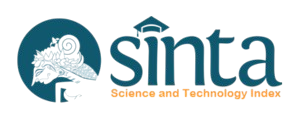FLIPPING THE CLASSROOM IN THE EFL READING FOR ACADEMIC PURPOSE COURSE DURING COVID-19: BARRIERS AND BOOSTERS
(1) Nusa Nipa University Indonesia
(*) Corresponding Author
Abstract
Keywords
Full Text:
PDFReferences
Abeysekera, L., & Dawson, P. (2016). Motivation and cognitive load in the flipped classroom: Definition, rationale, and a call for research. Higher Education Research and Development, 34(1), 1-14. https://doi.org/10.1080/07294360.2014.934336
Afrilyasanti, R., Cahyono, B. Y., & Astuti, U. P. (2017). Indonesian EFL students’ perceptions on the implementation of flipped classroom model. Journal of Language Teaching and Research. 8(3), 476-484. http://dx.doi.org/10.17507/jltr.0803.05
Ahmed, S. (2016). The flipped classroom model to develop Egyptian EFL students' listening comprehension. English Language Teaching, 9(9), 166-178. https://doi.org/10.5539/elt.v9n9p166
Arnold-Garza, S. (2014). The flipped classroom teaching model and its use for information literacy instruction. Communication in Information Literacy. 8(1), 7-22. https://doi.org/10.15760/comminfolit.2014.8.1.161
Bishop, J. L., Verleger, M. A. (2013). The flipped classroom: A survey of the research. In Proceedings of the 120th ASEE annual conference & exposition. American Society for Engineering Education. 30(9), 1-18. https://www.asee.org/public/conferences/20/papers/6219/download
Bohaty, B. S., Redford, G. J., & Gadbury-Amyot, C. C. (2016). Flipping the classroom: Assessment of strategies to promote student centered, self-directed learning in a dental school course in Pediatric Dentistry. Journal of Dental Education. 80(11), 1319–27. https://doi.org/10.1002/j.0022-0337.2016.80.11.tb06217.x
Brame, C., (2013). Flipping the classroom. Vanderbilt University Center for Teaching. http://cft.vanderbilt.edu/guides-sub-pages/flipping-the-classroom/
Bransford, J. D., Brown, A. L., & Cocking, R. R. (2000). How people learn: Brain, mind, experience, and school. National Academy Press.
Brooks, N., & Weaver, H. (2017). Two sides of the flip in middle grades ELA: Student and teacher perspectives. In: Young, C. A., & Moran, C. M. (eds) Applying the flipped classroom model to English Language Arts Education. IGI Global.
Creswell, J. W. (2012). Educational research: Planning, conducting and evaluating quantitative and qualitative research (4th ed). Pearson.
Crouch, C. H. & Mazur, E. (2001). Peer instruction: Ten years of experience and results. American Journal of Physics. 69(9), 970-977. https://doi.org/10.1119/1.1374249
Evseeva, A. & Solozhenko, A. (2015). Use of flipped classroom technology in language learning. XV International Conference "Linguistic and Cultural Studies: Traditions and Innovations". https://doi.org/10.1016/j.sbspro.2015.10.006
Fauzi, A. (2020). The in-class flip model in teaching speaking: Improving elementary students’ skill and learning process. Indonesian Journal of Educational Research and Review, 3(2), 64-71. http://dx.doi.org/10.23887/ijerr.v3i2.26600
Goodwin, B., & Miller, K. (2013). Research says evidence on flipped classrooms is still coming in. Technology-Rich Learning, 70(6), 78-80. https://www.ascd.org/el/articles/evidence-on-flipped-classrooms-is-still-coming-in
Hamouda, A. (2013). An investigation of listening comprehension problems encountered by Saudi students in the EFL listening classroom. International Journal of Academic Research in Progressive Education and Development, 2(2), 113–155. https://pdf4pro.com/view/an-investigation-of-listening-comprehension-problems-4e7c91.html
Hsieh, J. S. C., Wu, W. V., & Marek, M. W. (2016). Using the flipped classroom to enhance EFL learning. Computer Assisted Language Learning, 30(1-2), 1–25. https://doi.org/10.1080/09588221.2015.1111910
Jones, M. (2016). A case study of blended learning in higher education in Malaysia: Flipped, flopped, or forgotten?. 3rd Teaching & Education Conference, Barcelona, 132–13. https://doi.org/10.20472/TEC.2016.003.012
Khoiriyah. (2021). Flipping the classroom to enhance EFL students’ listening skill. Journal of English as a Foreign Language. 11(1), 21-41. https://doi.org/10.23971/jefl.v11i1.2010
Lage, M. J., Platt, G. J., & Tregalia, M. (2000). Inverting the classroom: A gateway to creating an inclusive learning environment. The Journal of Economic Education, 31(1), 30-43. https://doi.org/10.2307/1183338
Lee, G. & Wallace, A. (2018). Flipped learning in the English as a foreign language classroom: outcomes and perceptions. TESOL Quarterly, 52(1), 62–84. https://doi.org/10.1002/tesq.372
Lewis, C. E., Chen, D. C., & Relan, A. (2018). Implementation of a flipped classroom approach to promote active learning in the third-year surgery clerkship. American journal of surgery, 215(2), 298–303. https://doi.org/10.1016/j.amjsurg.2017.08.050
Lockwood, R. B. (2014). Flip it! Strategies for the ESL classroom. University of Michigan Press.
Maharsi, I., Wijayanti, Y. R., & Astari, T. R. (2021). Evaluating flipped classroom approach in EFL students’ reading classes. LLT Journal: A Journal on Language and Language Learning, 24(1), 92-102. https://doi.org/10.24071/llt.v24i1.2768
Marsh, D. (2012). Blended learning creating learning opportunities for language learners. Cambridge: Cambridge University Press.
Mehring, J. (2018). The flipped classroom. In: Mehring, J., & Leis, A. (eds). Innovations in flipping the language classroom. Singapore: Springer. https://doi.org/10.1007/978-981-10-6968-0_1
Moran, C., & Young, C. A. (2013). Active learning in the flipped English language arts classroom. In J. Keengwe, G. Onchwari, & J. Oigara (Eds.), Promoting active learning through the flipped classroom model. IGI Global.
Pudin, C. S. J. (2017). Exploring a flipped learning approach to teaching grammar for ESL students. Indonesian Journal of English Language Teaching and Applied Linguistics, 2(1), 51–64. https://doi.org/10.21093/ijeltal.v2i1.47
Rintaningrum, R. (2018). Investigating reasons why listening in English is difficult: Voice from foreign language learners. Asian EFL Journal, 20(11), 112–120. https://www.asian-efl-journal.com
Rotellar, C., & Cain, J. (2016). Research, perspectives, and recommendations on implementing the flipped classroom. American Journal of Pharmaceutical Education, 80(2),34. https://doi.org/10.5688/ajpe80234
Schell, J. (2012). Use of the term flipped classroom. Turn to your neighbor: The official peer instruction blog. Retrieved from https://blog.peerinstruction.net/useof-the- term-flipped-classroom/
Shih, H. J., & Huang, S. C. (2019). College students’ metacognitive strategy use in an EFL flipped classroom. Computer Assisted Language Learning, 33(7), 755-784. https://doi.org/10.1080/09588221.2019.1590420
Strayer, J. F. (2012). How learning in an inverted classroom influences cooperation, innovation and task orientation. Learning Environments Research, 15(2), 171–193. https://doi.org/10.1007/s10984-012-9108-4
Sugiyono. (2016). Metode penelitian pendidikan: Pendekatan kuantitatif, kulaitatif, dan R&D. Penerbit Alfabeta
Voss, E., & Kostka, I. (2019). Flipping academic English language learning; Experiences from an American university. Springer
Young, C. A., & Moran, C. M. (2017). Applying the flipped classroom model to English Language Arts Education. IGI Global.
DOI: https://doi.org/10.24071/llt.v25i1.4245
Refbacks
- There are currently no refbacks.
Copyright (c) 2022 Stefanus Igolois G. Uran

This work is licensed under a Creative Commons Attribution-ShareAlike 4.0 International License.
LLT Journal: A Journal on Language and Language Teaching Sinta 1 Certificate
.jpg)

This work is licensed under CC BY-SA.
Creative Commons Attribution-ShareAlike 4.0 International License


.png)


















